Analyzing Demand and Supply with Economic Theories in Business
VerifiedAdded on 2023/06/09
|12
|3468
|351
Report
AI Summary
This report provides an analysis of contemporary business economics, focusing on the laws of demand and supply, and various economic theories from the 20th and 21st centuries. It uses Unilever as an example to explain the law of demand, including movements along the demand curve and factors that influence it, such as taste, income, and advertisement expenditure. The report also elaborates on the law of supply, the supply curve, and elements affecting the supply curve, like the number of sellers, prices, taxes, subsidies, and technology. Furthermore, it distinguishes between different economic theories, particularly highlighting Keynesian economics and its application in modern economics, emphasizing the role of government intervention through fiscal and monetary policies. The report concludes by underscoring the importance of understanding these economic principles for effective resource utilization and economic stability.
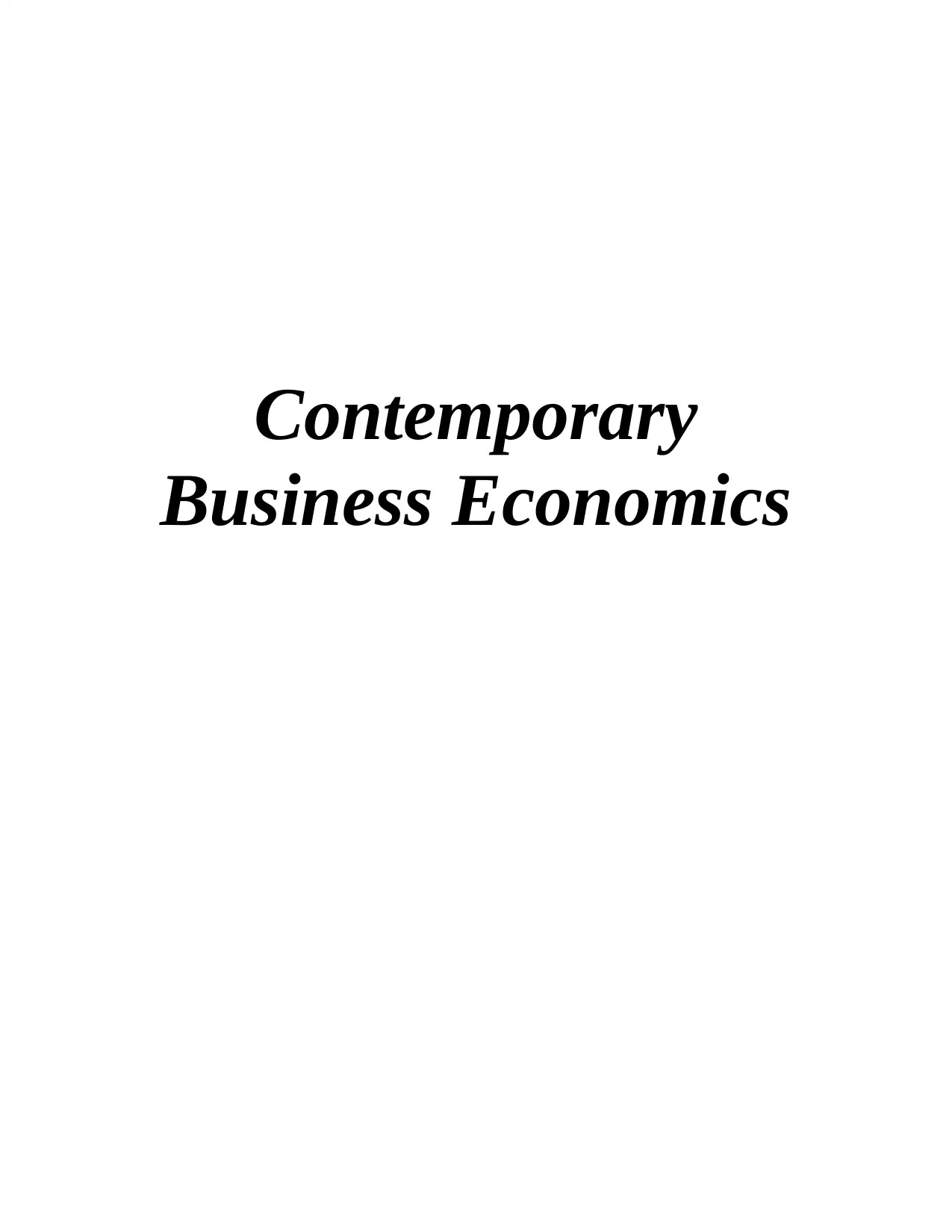
Contemporary
Business Economics
Business Economics
Paraphrase This Document
Need a fresh take? Get an instant paraphrase of this document with our AI Paraphraser
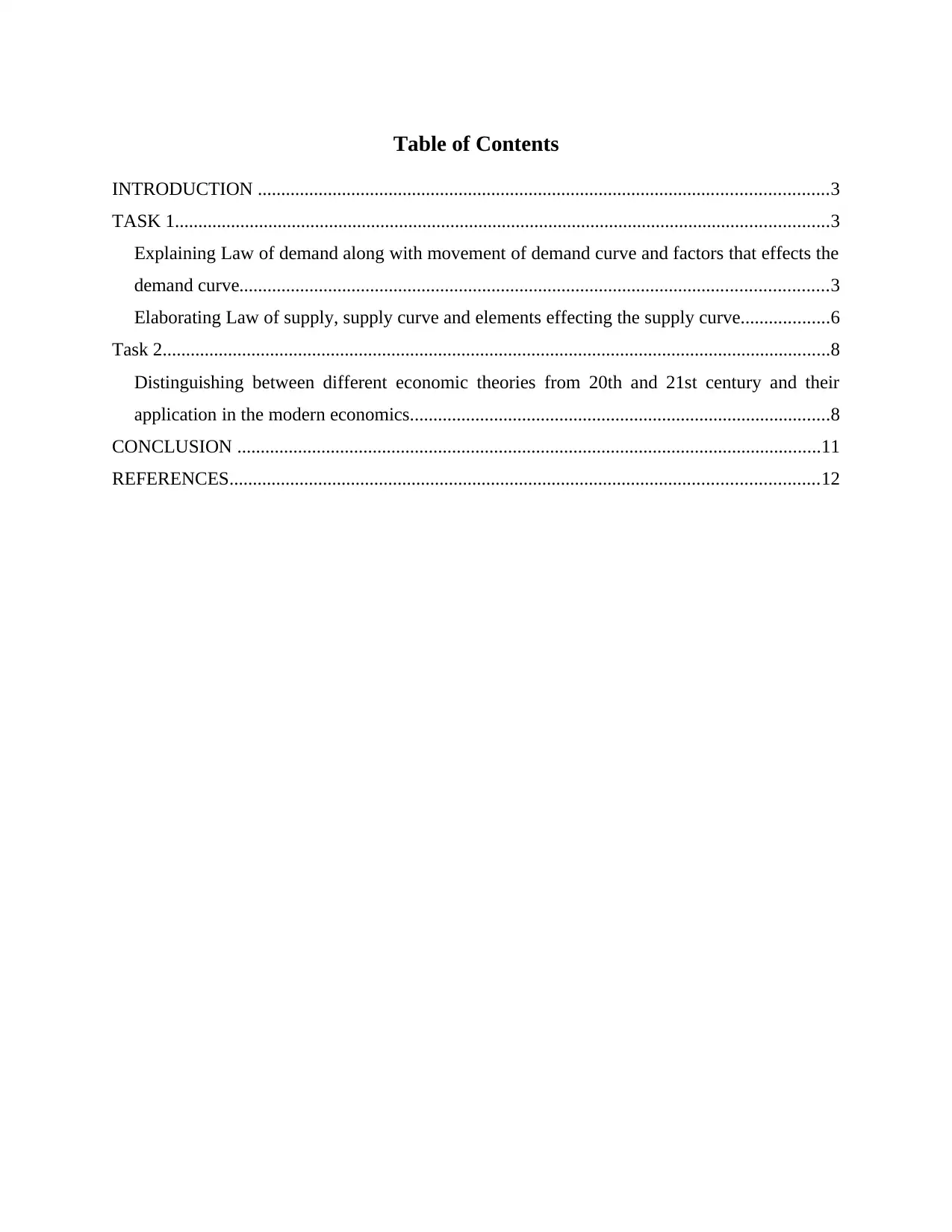
Table of Contents
INTRODUCTION ..........................................................................................................................3
TASK 1............................................................................................................................................3
Explaining Law of demand along with movement of demand curve and factors that effects the
demand curve..............................................................................................................................3
Elaborating Law of supply, supply curve and elements effecting the supply curve...................6
Task 2...............................................................................................................................................8
Distinguishing between different economic theories from 20th and 21st century and their
application in the modern economics..........................................................................................8
CONCLUSION .............................................................................................................................11
REFERENCES..............................................................................................................................12
INTRODUCTION ..........................................................................................................................3
TASK 1............................................................................................................................................3
Explaining Law of demand along with movement of demand curve and factors that effects the
demand curve..............................................................................................................................3
Elaborating Law of supply, supply curve and elements effecting the supply curve...................6
Task 2...............................................................................................................................................8
Distinguishing between different economic theories from 20th and 21st century and their
application in the modern economics..........................................................................................8
CONCLUSION .............................................................................................................................11
REFERENCES..............................................................................................................................12
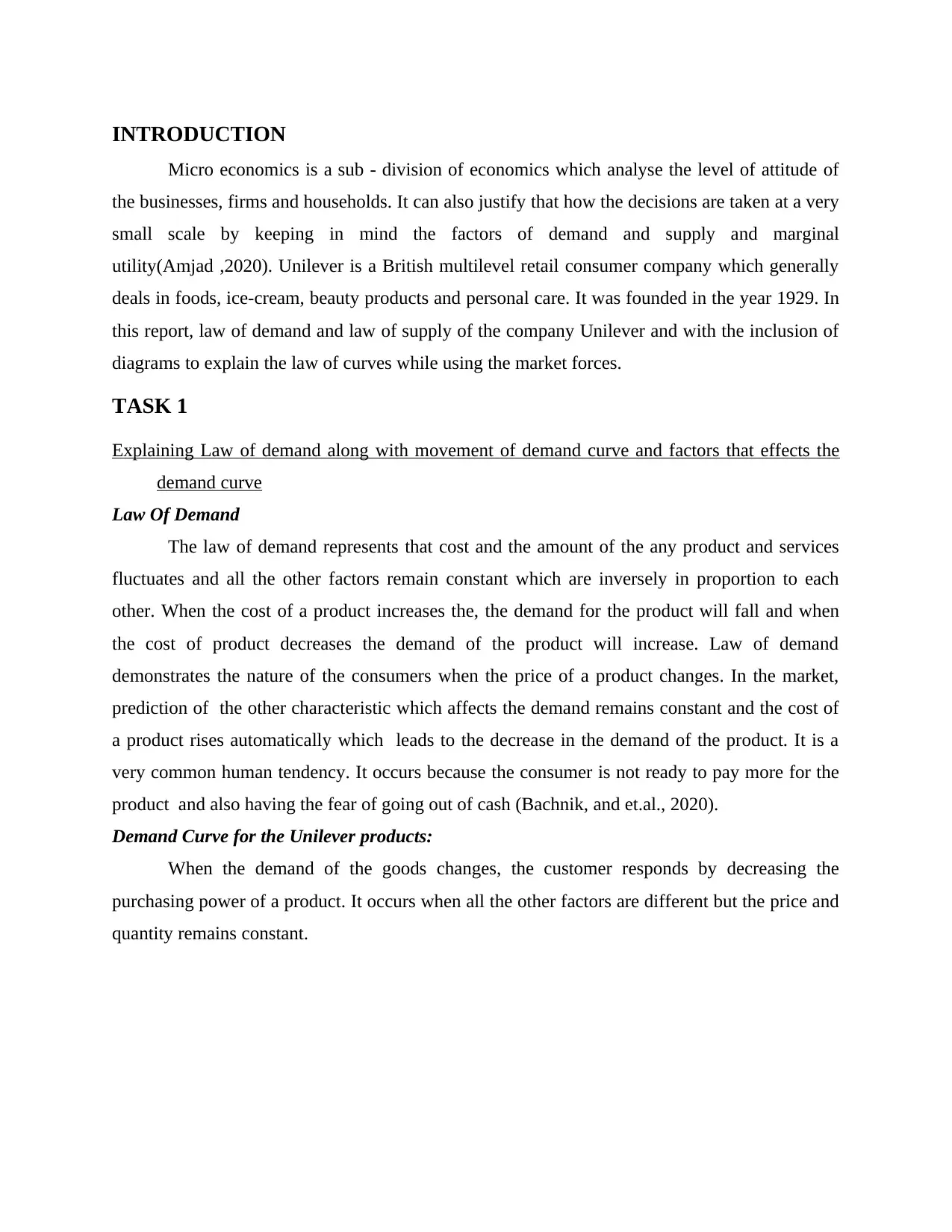
INTRODUCTION
Micro economics is a sub - division of economics which analyse the level of attitude of
the businesses, firms and households. It can also justify that how the decisions are taken at a very
small scale by keeping in mind the factors of demand and supply and marginal
utility(Amjad ,2020). Unilever is a British multilevel retail consumer company which generally
deals in foods, ice-cream, beauty products and personal care. It was founded in the year 1929. In
this report, law of demand and law of supply of the company Unilever and with the inclusion of
diagrams to explain the law of curves while using the market forces.
TASK 1
Explaining Law of demand along with movement of demand curve and factors that effects the
demand curve
Law Of Demand
The law of demand represents that cost and the amount of the any product and services
fluctuates and all the other factors remain constant which are inversely in proportion to each
other. When the cost of a product increases the, the demand for the product will fall and when
the cost of product decreases the demand of the product will increase. Law of demand
demonstrates the nature of the consumers when the price of a product changes. In the market,
prediction of the other characteristic which affects the demand remains constant and the cost of
a product rises automatically which leads to the decrease in the demand of the product. It is a
very common human tendency. It occurs because the consumer is not ready to pay more for the
product and also having the fear of going out of cash (Bachnik, and et.al., 2020).
Demand Curve for the Unilever products:
When the demand of the goods changes, the customer responds by decreasing the
purchasing power of a product. It occurs when all the other factors are different but the price and
quantity remains constant.
Micro economics is a sub - division of economics which analyse the level of attitude of
the businesses, firms and households. It can also justify that how the decisions are taken at a very
small scale by keeping in mind the factors of demand and supply and marginal
utility(Amjad ,2020). Unilever is a British multilevel retail consumer company which generally
deals in foods, ice-cream, beauty products and personal care. It was founded in the year 1929. In
this report, law of demand and law of supply of the company Unilever and with the inclusion of
diagrams to explain the law of curves while using the market forces.
TASK 1
Explaining Law of demand along with movement of demand curve and factors that effects the
demand curve
Law Of Demand
The law of demand represents that cost and the amount of the any product and services
fluctuates and all the other factors remain constant which are inversely in proportion to each
other. When the cost of a product increases the, the demand for the product will fall and when
the cost of product decreases the demand of the product will increase. Law of demand
demonstrates the nature of the consumers when the price of a product changes. In the market,
prediction of the other characteristic which affects the demand remains constant and the cost of
a product rises automatically which leads to the decrease in the demand of the product. It is a
very common human tendency. It occurs because the consumer is not ready to pay more for the
product and also having the fear of going out of cash (Bachnik, and et.al., 2020).
Demand Curve for the Unilever products:
When the demand of the goods changes, the customer responds by decreasing the
purchasing power of a product. It occurs when all the other factors are different but the price and
quantity remains constant.
⊘ This is a preview!⊘
Do you want full access?
Subscribe today to unlock all pages.

Trusted by 1+ million students worldwide
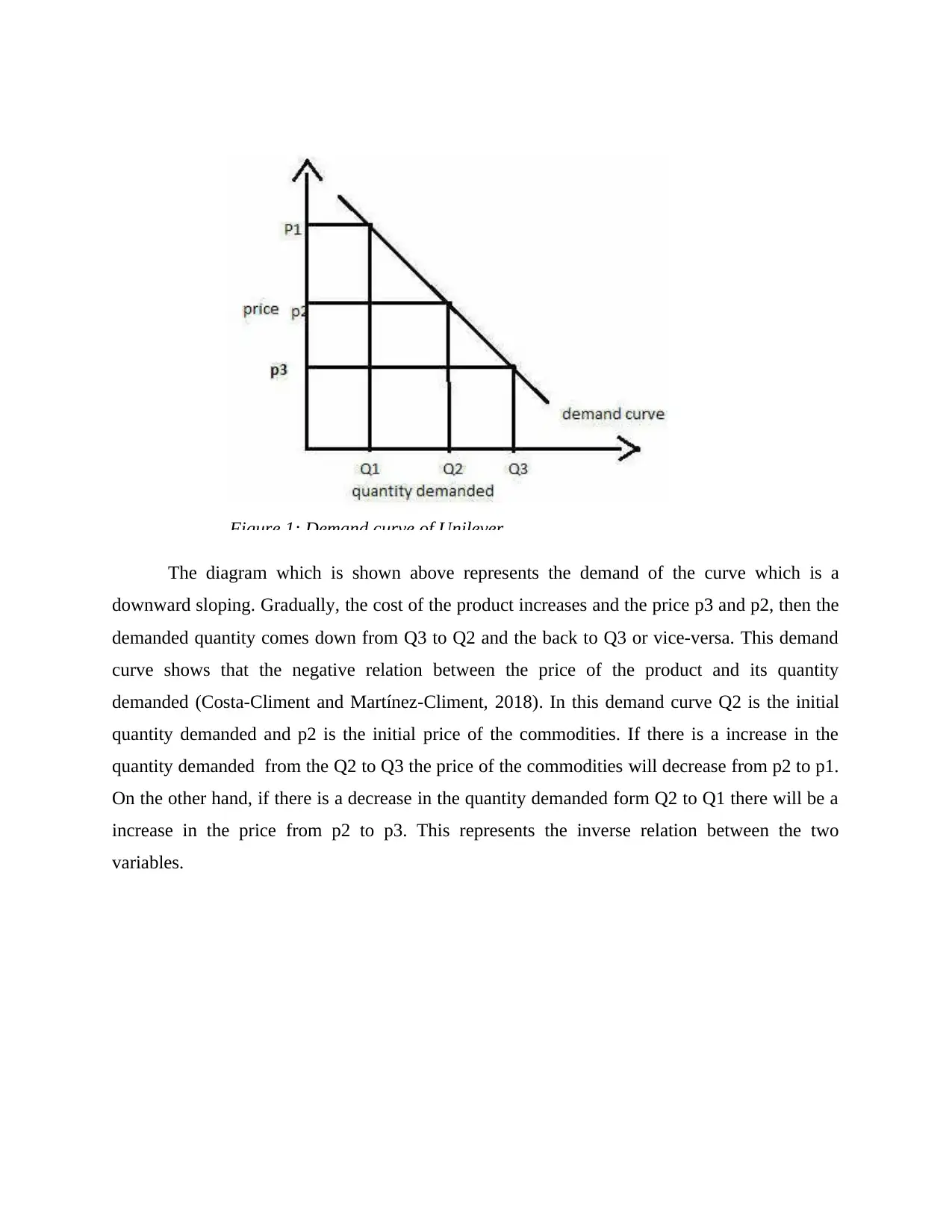
The diagram which is shown above represents the demand of the curve which is a
downward sloping. Gradually, the cost of the product increases and the price p3 and p2, then the
demanded quantity comes down from Q3 to Q2 and the back to Q3 or vice-versa. This demand
curve shows that the negative relation between the price of the product and its quantity
demanded (Costa-Climent and Martínez-Climent, 2018). In this demand curve Q2 is the initial
quantity demanded and p2 is the initial price of the commodities. If there is a increase in the
quantity demanded from the Q2 to Q3 the price of the commodities will decrease from p2 to p1.
On the other hand, if there is a decrease in the quantity demanded form Q2 to Q1 there will be a
increase in the price from p2 to p3. This represents the inverse relation between the two
variables.
Figure 1: Demand curve of Unilever
downward sloping. Gradually, the cost of the product increases and the price p3 and p2, then the
demanded quantity comes down from Q3 to Q2 and the back to Q3 or vice-versa. This demand
curve shows that the negative relation between the price of the product and its quantity
demanded (Costa-Climent and Martínez-Climent, 2018). In this demand curve Q2 is the initial
quantity demanded and p2 is the initial price of the commodities. If there is a increase in the
quantity demanded from the Q2 to Q3 the price of the commodities will decrease from p2 to p1.
On the other hand, if there is a decrease in the quantity demanded form Q2 to Q1 there will be a
increase in the price from p2 to p3. This represents the inverse relation between the two
variables.
Figure 1: Demand curve of Unilever
Paraphrase This Document
Need a fresh take? Get an instant paraphrase of this document with our AI Paraphraser
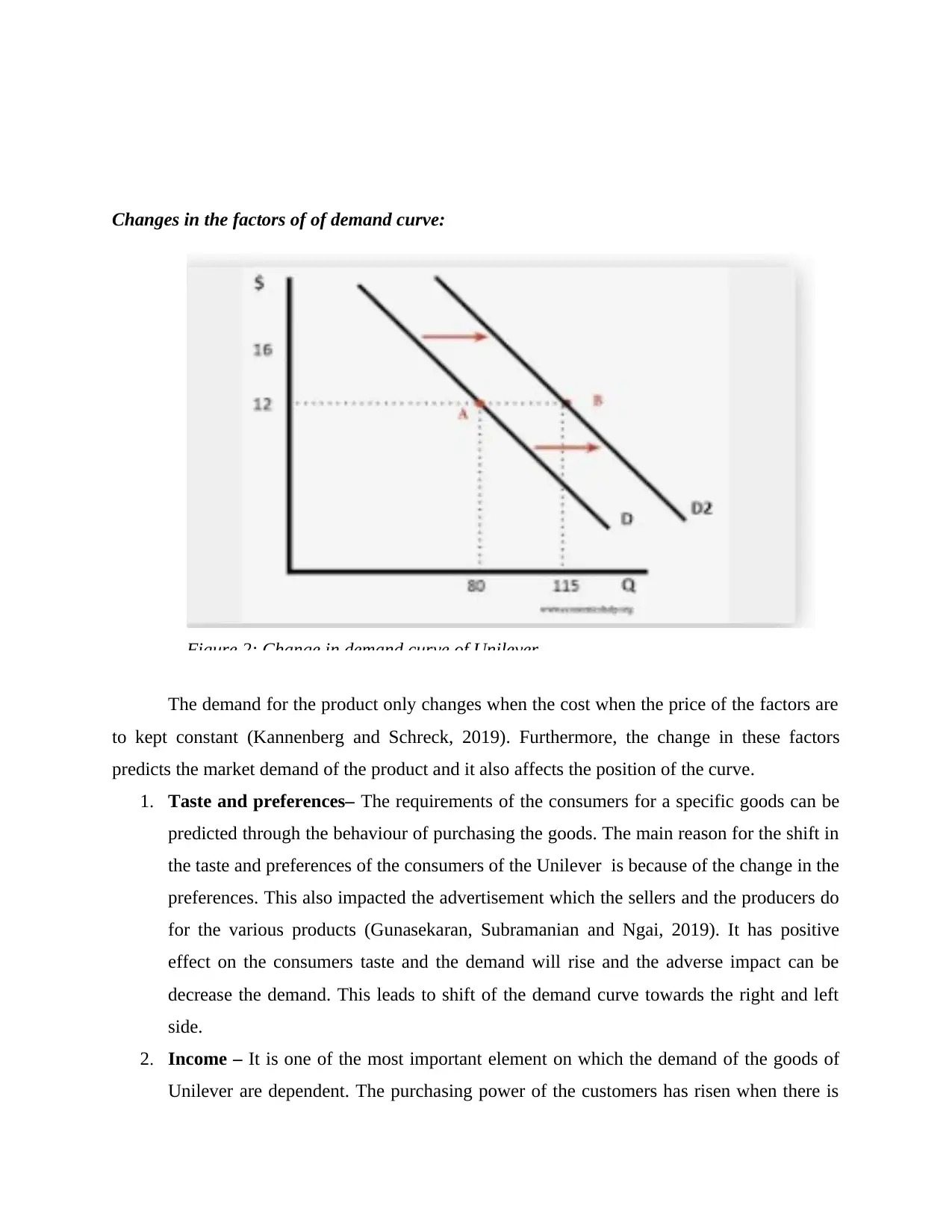
Changes in the factors of of demand curve:
The demand for the product only changes when the cost when the price of the factors are
to kept constant (Kannenberg and Schreck, 2019). Furthermore, the change in these factors
predicts the market demand of the product and it also affects the position of the curve.
1. Taste and preferences– The requirements of the consumers for a specific goods can be
predicted through the behaviour of purchasing the goods. The main reason for the shift in
the taste and preferences of the consumers of the Unilever is because of the change in the
preferences. This also impacted the advertisement which the sellers and the producers do
for the various products (Gunasekaran, Subramanian and Ngai, 2019). It has positive
effect on the consumers taste and the demand will rise and the adverse impact can be
decrease the demand. This leads to shift of the demand curve towards the right and left
side.
2. Income – It is one of the most important element on which the demand of the goods of
Unilever are dependent. The purchasing power of the customers has risen when there is
Figure 2: Change in demand curve of Unilever
The demand for the product only changes when the cost when the price of the factors are
to kept constant (Kannenberg and Schreck, 2019). Furthermore, the change in these factors
predicts the market demand of the product and it also affects the position of the curve.
1. Taste and preferences– The requirements of the consumers for a specific goods can be
predicted through the behaviour of purchasing the goods. The main reason for the shift in
the taste and preferences of the consumers of the Unilever is because of the change in the
preferences. This also impacted the advertisement which the sellers and the producers do
for the various products (Gunasekaran, Subramanian and Ngai, 2019). It has positive
effect on the consumers taste and the demand will rise and the adverse impact can be
decrease the demand. This leads to shift of the demand curve towards the right and left
side.
2. Income – It is one of the most important element on which the demand of the goods of
Unilever are dependent. The purchasing power of the customers has risen when there is
Figure 2: Change in demand curve of Unilever
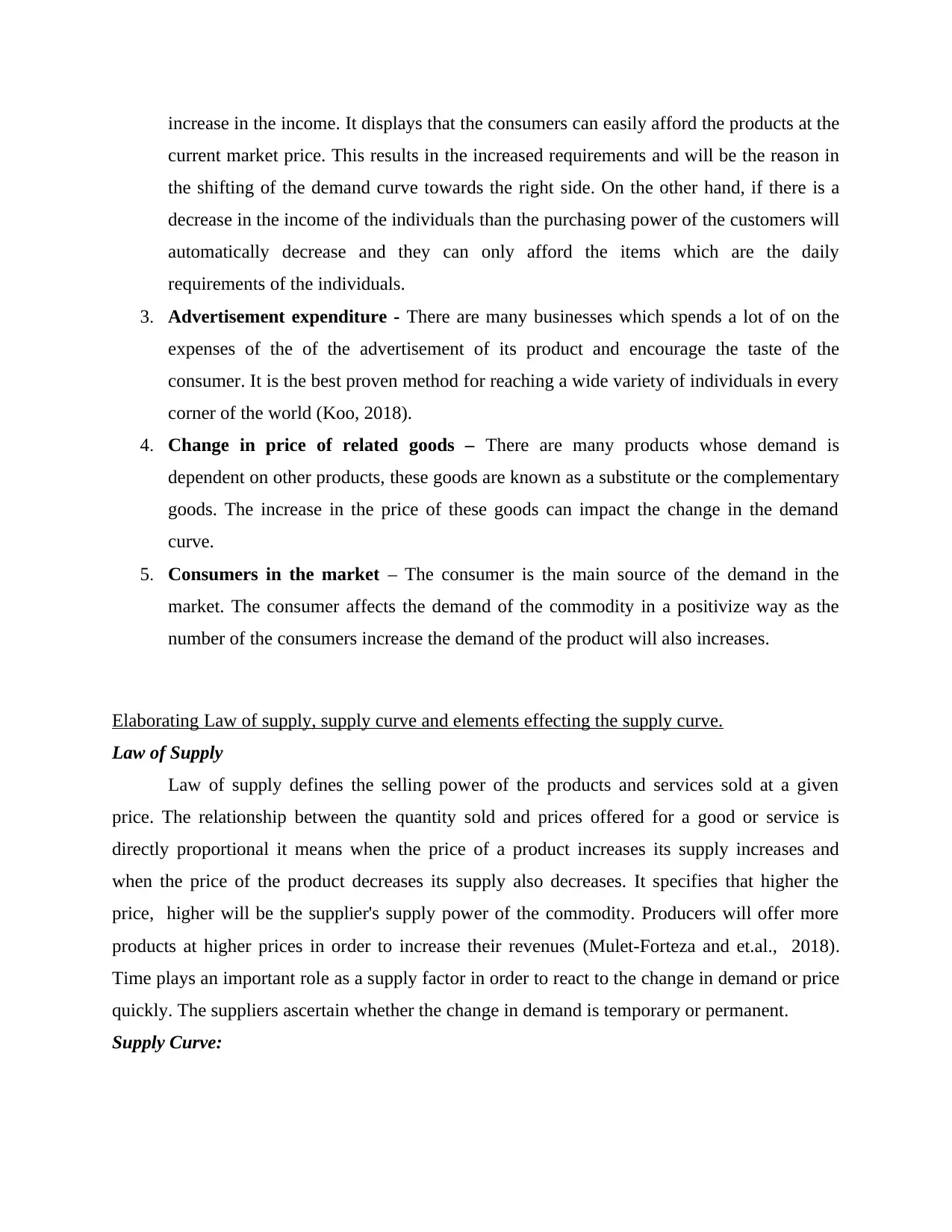
increase in the income. It displays that the consumers can easily afford the products at the
current market price. This results in the increased requirements and will be the reason in
the shifting of the demand curve towards the right side. On the other hand, if there is a
decrease in the income of the individuals than the purchasing power of the customers will
automatically decrease and they can only afford the items which are the daily
requirements of the individuals.
3. Advertisement expenditure - There are many businesses which spends a lot of on the
expenses of the of the advertisement of its product and encourage the taste of the
consumer. It is the best proven method for reaching a wide variety of individuals in every
corner of the world (Koo, 2018).
4. Change in price of related goods – There are many products whose demand is
dependent on other products, these goods are known as a substitute or the complementary
goods. The increase in the price of these goods can impact the change in the demand
curve.
5. Consumers in the market – The consumer is the main source of the demand in the
market. The consumer affects the demand of the commodity in a positivize way as the
number of the consumers increase the demand of the product will also increases.
Elaborating Law of supply, supply curve and elements effecting the supply curve.
Law of Supply
Law of supply defines the selling power of the products and services sold at a given
price. The relationship between the quantity sold and prices offered for a good or service is
directly proportional it means when the price of a product increases its supply increases and
when the price of the product decreases its supply also decreases. It specifies that higher the
price, higher will be the supplier's supply power of the commodity. Producers will offer more
products at higher prices in order to increase their revenues (Mulet-Forteza and et.al., 2018).
Time plays an important role as a supply factor in order to react to the change in demand or price
quickly. The suppliers ascertain whether the change in demand is temporary or permanent.
Supply Curve:
current market price. This results in the increased requirements and will be the reason in
the shifting of the demand curve towards the right side. On the other hand, if there is a
decrease in the income of the individuals than the purchasing power of the customers will
automatically decrease and they can only afford the items which are the daily
requirements of the individuals.
3. Advertisement expenditure - There are many businesses which spends a lot of on the
expenses of the of the advertisement of its product and encourage the taste of the
consumer. It is the best proven method for reaching a wide variety of individuals in every
corner of the world (Koo, 2018).
4. Change in price of related goods – There are many products whose demand is
dependent on other products, these goods are known as a substitute or the complementary
goods. The increase in the price of these goods can impact the change in the demand
curve.
5. Consumers in the market – The consumer is the main source of the demand in the
market. The consumer affects the demand of the commodity in a positivize way as the
number of the consumers increase the demand of the product will also increases.
Elaborating Law of supply, supply curve and elements effecting the supply curve.
Law of Supply
Law of supply defines the selling power of the products and services sold at a given
price. The relationship between the quantity sold and prices offered for a good or service is
directly proportional it means when the price of a product increases its supply increases and
when the price of the product decreases its supply also decreases. It specifies that higher the
price, higher will be the supplier's supply power of the commodity. Producers will offer more
products at higher prices in order to increase their revenues (Mulet-Forteza and et.al., 2018).
Time plays an important role as a supply factor in order to react to the change in demand or price
quickly. The suppliers ascertain whether the change in demand is temporary or permanent.
Supply Curve:
⊘ This is a preview!⊘
Do you want full access?
Subscribe today to unlock all pages.

Trusted by 1+ million students worldwide
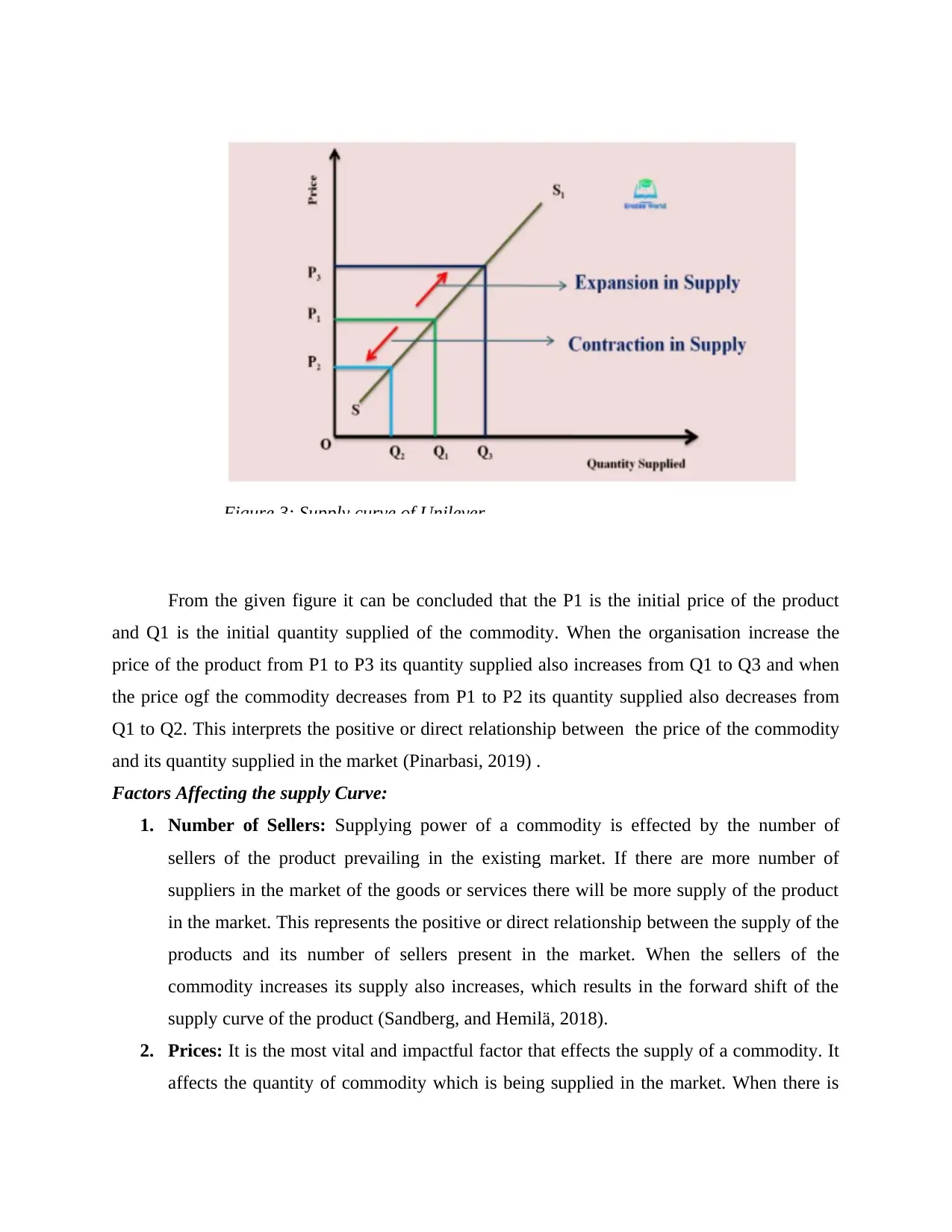
From the given figure it can be concluded that the P1 is the initial price of the product
and Q1 is the initial quantity supplied of the commodity. When the organisation increase the
price of the product from P1 to P3 its quantity supplied also increases from Q1 to Q3 and when
the price ogf the commodity decreases from P1 to P2 its quantity supplied also decreases from
Q1 to Q2. This interprets the positive or direct relationship between the price of the commodity
and its quantity supplied in the market (Pinarbasi, 2019) .
Factors Affecting the supply Curve:
1. Number of Sellers: Supplying power of a commodity is effected by the number of
sellers of the product prevailing in the existing market. If there are more number of
suppliers in the market of the goods or services there will be more supply of the product
in the market. This represents the positive or direct relationship between the supply of the
products and its number of sellers present in the market. When the sellers of the
commodity increases its supply also increases, which results in the forward shift of the
supply curve of the product (Sandberg, and Hemilä, 2018).
2. Prices: It is the most vital and impactful factor that effects the supply of a commodity. It
affects the quantity of commodity which is being supplied in the market. When there is
Figure 3: Supply curve of Unilever
and Q1 is the initial quantity supplied of the commodity. When the organisation increase the
price of the product from P1 to P3 its quantity supplied also increases from Q1 to Q3 and when
the price ogf the commodity decreases from P1 to P2 its quantity supplied also decreases from
Q1 to Q2. This interprets the positive or direct relationship between the price of the commodity
and its quantity supplied in the market (Pinarbasi, 2019) .
Factors Affecting the supply Curve:
1. Number of Sellers: Supplying power of a commodity is effected by the number of
sellers of the product prevailing in the existing market. If there are more number of
suppliers in the market of the goods or services there will be more supply of the product
in the market. This represents the positive or direct relationship between the supply of the
products and its number of sellers present in the market. When the sellers of the
commodity increases its supply also increases, which results in the forward shift of the
supply curve of the product (Sandberg, and Hemilä, 2018).
2. Prices: It is the most vital and impactful factor that effects the supply of a commodity. It
affects the quantity of commodity which is being supplied in the market. When there is
Figure 3: Supply curve of Unilever
Paraphrase This Document
Need a fresh take? Get an instant paraphrase of this document with our AI Paraphraser
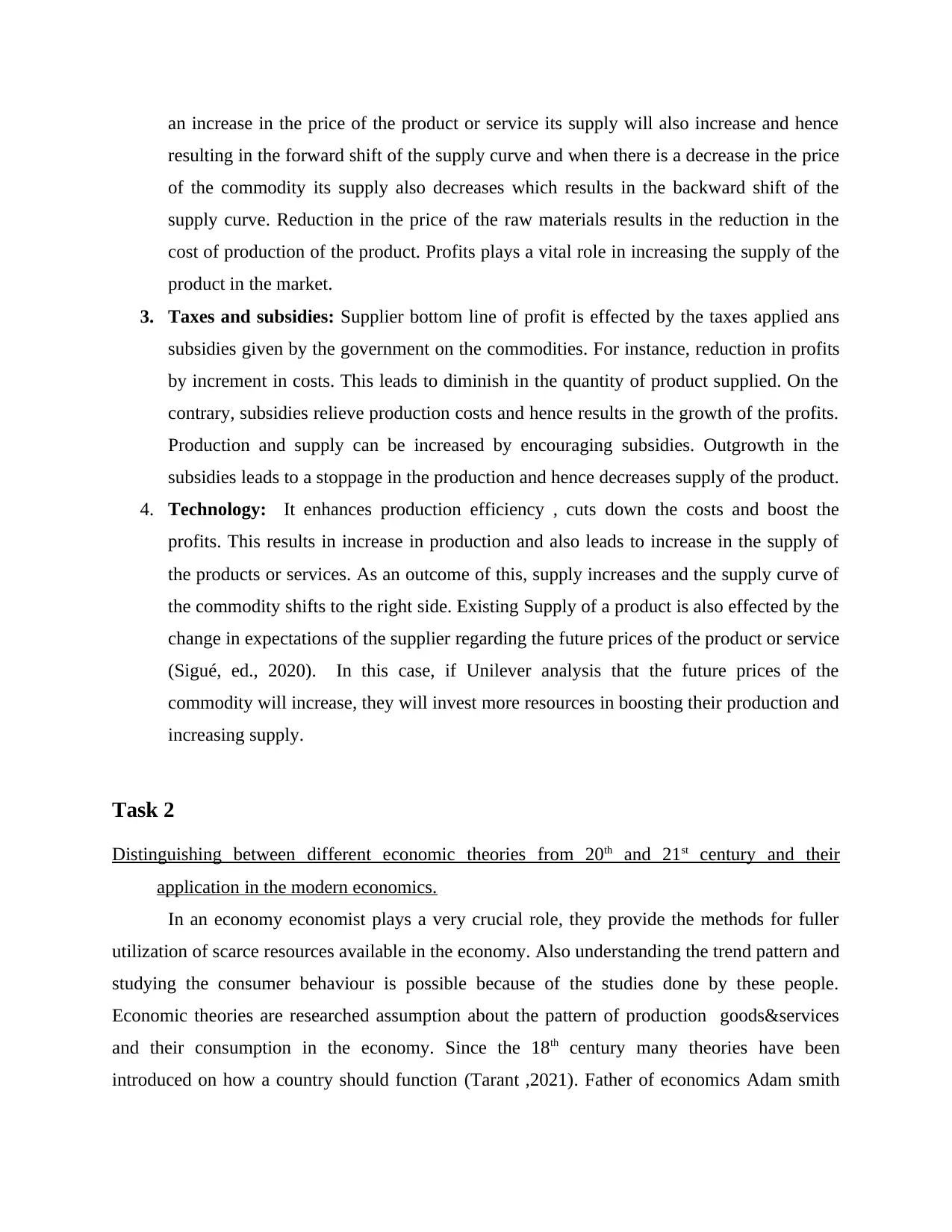
an increase in the price of the product or service its supply will also increase and hence
resulting in the forward shift of the supply curve and when there is a decrease in the price
of the commodity its supply also decreases which results in the backward shift of the
supply curve. Reduction in the price of the raw materials results in the reduction in the
cost of production of the product. Profits plays a vital role in increasing the supply of the
product in the market.
3. Taxes and subsidies: Supplier bottom line of profit is effected by the taxes applied ans
subsidies given by the government on the commodities. For instance, reduction in profits
by increment in costs. This leads to diminish in the quantity of product supplied. On the
contrary, subsidies relieve production costs and hence results in the growth of the profits.
Production and supply can be increased by encouraging subsidies. Outgrowth in the
subsidies leads to a stoppage in the production and hence decreases supply of the product.
4. Technology: It enhances production efficiency , cuts down the costs and boost the
profits. This results in increase in production and also leads to increase in the supply of
the products or services. As an outcome of this, supply increases and the supply curve of
the commodity shifts to the right side. Existing Supply of a product is also effected by the
change in expectations of the supplier regarding the future prices of the product or service
(Sigué, ed., 2020). In this case, if Unilever analysis that the future prices of the
commodity will increase, they will invest more resources in boosting their production and
increasing supply.
Task 2
Distinguishing between different economic theories from 20th and 21st century and their
application in the modern economics.
In an economy economist plays a very crucial role, they provide the methods for fuller
utilization of scarce resources available in the economy. Also understanding the trend pattern and
studying the consumer behaviour is possible because of the studies done by these people.
Economic theories are researched assumption about the pattern of production goods&services
and their consumption in the economy. Since the 18th century many theories have been
introduced on how a country should function (Tarant ,2021). Father of economics Adam smith
resulting in the forward shift of the supply curve and when there is a decrease in the price
of the commodity its supply also decreases which results in the backward shift of the
supply curve. Reduction in the price of the raw materials results in the reduction in the
cost of production of the product. Profits plays a vital role in increasing the supply of the
product in the market.
3. Taxes and subsidies: Supplier bottom line of profit is effected by the taxes applied ans
subsidies given by the government on the commodities. For instance, reduction in profits
by increment in costs. This leads to diminish in the quantity of product supplied. On the
contrary, subsidies relieve production costs and hence results in the growth of the profits.
Production and supply can be increased by encouraging subsidies. Outgrowth in the
subsidies leads to a stoppage in the production and hence decreases supply of the product.
4. Technology: It enhances production efficiency , cuts down the costs and boost the
profits. This results in increase in production and also leads to increase in the supply of
the products or services. As an outcome of this, supply increases and the supply curve of
the commodity shifts to the right side. Existing Supply of a product is also effected by the
change in expectations of the supplier regarding the future prices of the product or service
(Sigué, ed., 2020). In this case, if Unilever analysis that the future prices of the
commodity will increase, they will invest more resources in boosting their production and
increasing supply.
Task 2
Distinguishing between different economic theories from 20th and 21st century and their
application in the modern economics.
In an economy economist plays a very crucial role, they provide the methods for fuller
utilization of scarce resources available in the economy. Also understanding the trend pattern and
studying the consumer behaviour is possible because of the studies done by these people.
Economic theories are researched assumption about the pattern of production goods&services
and their consumption in the economy. Since the 18th century many theories have been
introduced on how a country should function (Tarant ,2021). Father of economics Adam smith
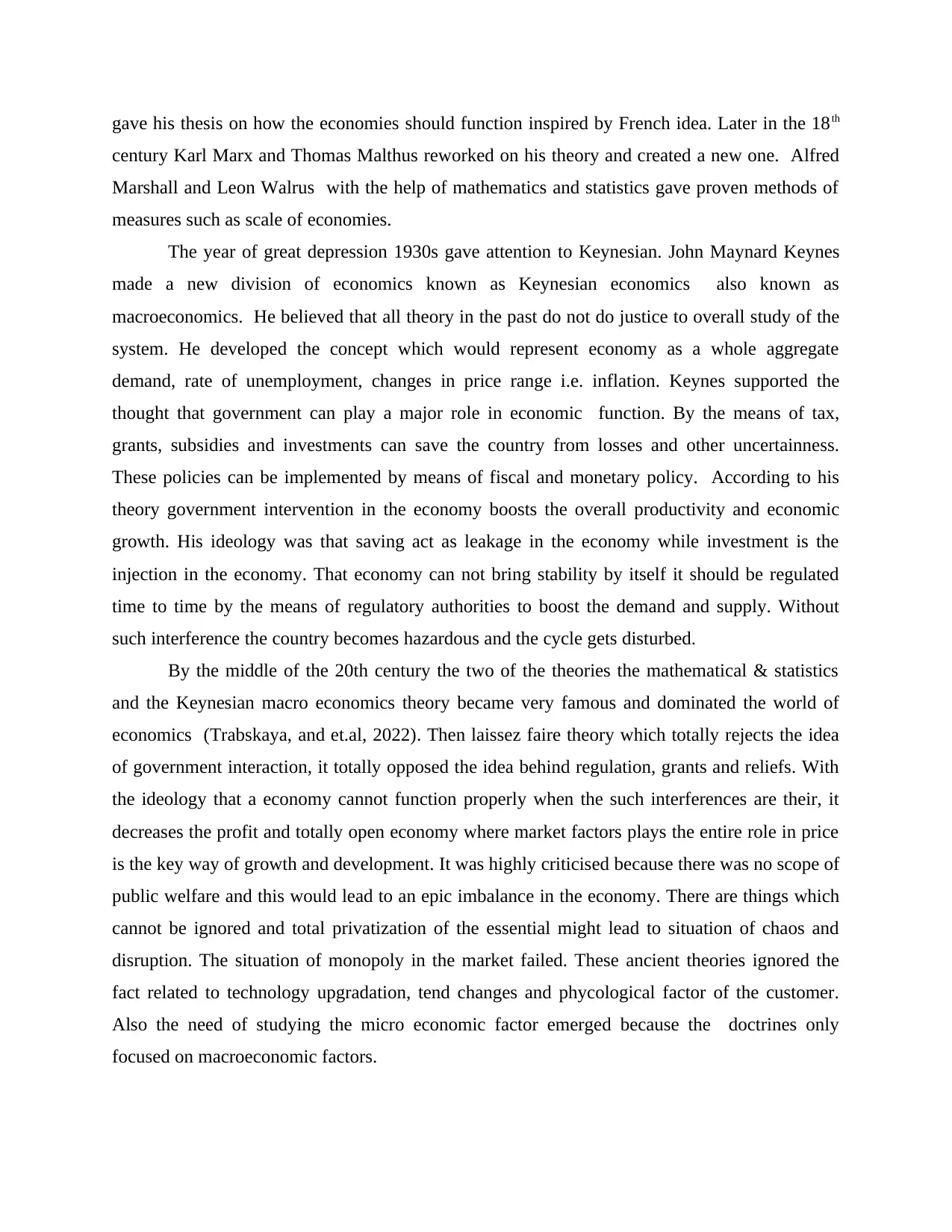
gave his thesis on how the economies should function inspired by French idea. Later in the 18th
century Karl Marx and Thomas Malthus reworked on his theory and created a new one. Alfred
Marshall and Leon Walrus with the help of mathematics and statistics gave proven methods of
measures such as scale of economies.
The year of great depression 1930s gave attention to Keynesian. John Maynard Keynes
made a new division of economics known as Keynesian economics also known as
macroeconomics. He believed that all theory in the past do not do justice to overall study of the
system. He developed the concept which would represent economy as a whole aggregate
demand, rate of unemployment, changes in price range i.e. inflation. Keynes supported the
thought that government can play a major role in economic function. By the means of tax,
grants, subsidies and investments can save the country from losses and other uncertainness.
These policies can be implemented by means of fiscal and monetary policy. According to his
theory government intervention in the economy boosts the overall productivity and economic
growth. His ideology was that saving act as leakage in the economy while investment is the
injection in the economy. That economy can not bring stability by itself it should be regulated
time to time by the means of regulatory authorities to boost the demand and supply. Without
such interference the country becomes hazardous and the cycle gets disturbed.
By the middle of the 20th century the two of the theories the mathematical & statistics
and the Keynesian macro economics theory became very famous and dominated the world of
economics (Trabskaya, and et.al, 2022). Then laissez faire theory which totally rejects the idea
of government interaction, it totally opposed the idea behind regulation, grants and reliefs. With
the ideology that a economy cannot function properly when the such interferences are their, it
decreases the profit and totally open economy where market factors plays the entire role in price
is the key way of growth and development. It was highly criticised because there was no scope of
public welfare and this would lead to an epic imbalance in the economy. There are things which
cannot be ignored and total privatization of the essential might lead to situation of chaos and
disruption. The situation of monopoly in the market failed. These ancient theories ignored the
fact related to technology upgradation, tend changes and phycological factor of the customer.
Also the need of studying the micro economic factor emerged because the doctrines only
focused on macroeconomic factors.
century Karl Marx and Thomas Malthus reworked on his theory and created a new one. Alfred
Marshall and Leon Walrus with the help of mathematics and statistics gave proven methods of
measures such as scale of economies.
The year of great depression 1930s gave attention to Keynesian. John Maynard Keynes
made a new division of economics known as Keynesian economics also known as
macroeconomics. He believed that all theory in the past do not do justice to overall study of the
system. He developed the concept which would represent economy as a whole aggregate
demand, rate of unemployment, changes in price range i.e. inflation. Keynes supported the
thought that government can play a major role in economic function. By the means of tax,
grants, subsidies and investments can save the country from losses and other uncertainness.
These policies can be implemented by means of fiscal and monetary policy. According to his
theory government intervention in the economy boosts the overall productivity and economic
growth. His ideology was that saving act as leakage in the economy while investment is the
injection in the economy. That economy can not bring stability by itself it should be regulated
time to time by the means of regulatory authorities to boost the demand and supply. Without
such interference the country becomes hazardous and the cycle gets disturbed.
By the middle of the 20th century the two of the theories the mathematical & statistics
and the Keynesian macro economics theory became very famous and dominated the world of
economics (Trabskaya, and et.al, 2022). Then laissez faire theory which totally rejects the idea
of government interaction, it totally opposed the idea behind regulation, grants and reliefs. With
the ideology that a economy cannot function properly when the such interferences are their, it
decreases the profit and totally open economy where market factors plays the entire role in price
is the key way of growth and development. It was highly criticised because there was no scope of
public welfare and this would lead to an epic imbalance in the economy. There are things which
cannot be ignored and total privatization of the essential might lead to situation of chaos and
disruption. The situation of monopoly in the market failed. These ancient theories ignored the
fact related to technology upgradation, tend changes and phycological factor of the customer.
Also the need of studying the micro economic factor emerged because the doctrines only
focused on macroeconomic factors.
⊘ This is a preview!⊘
Do you want full access?
Subscribe today to unlock all pages.

Trusted by 1+ million students worldwide
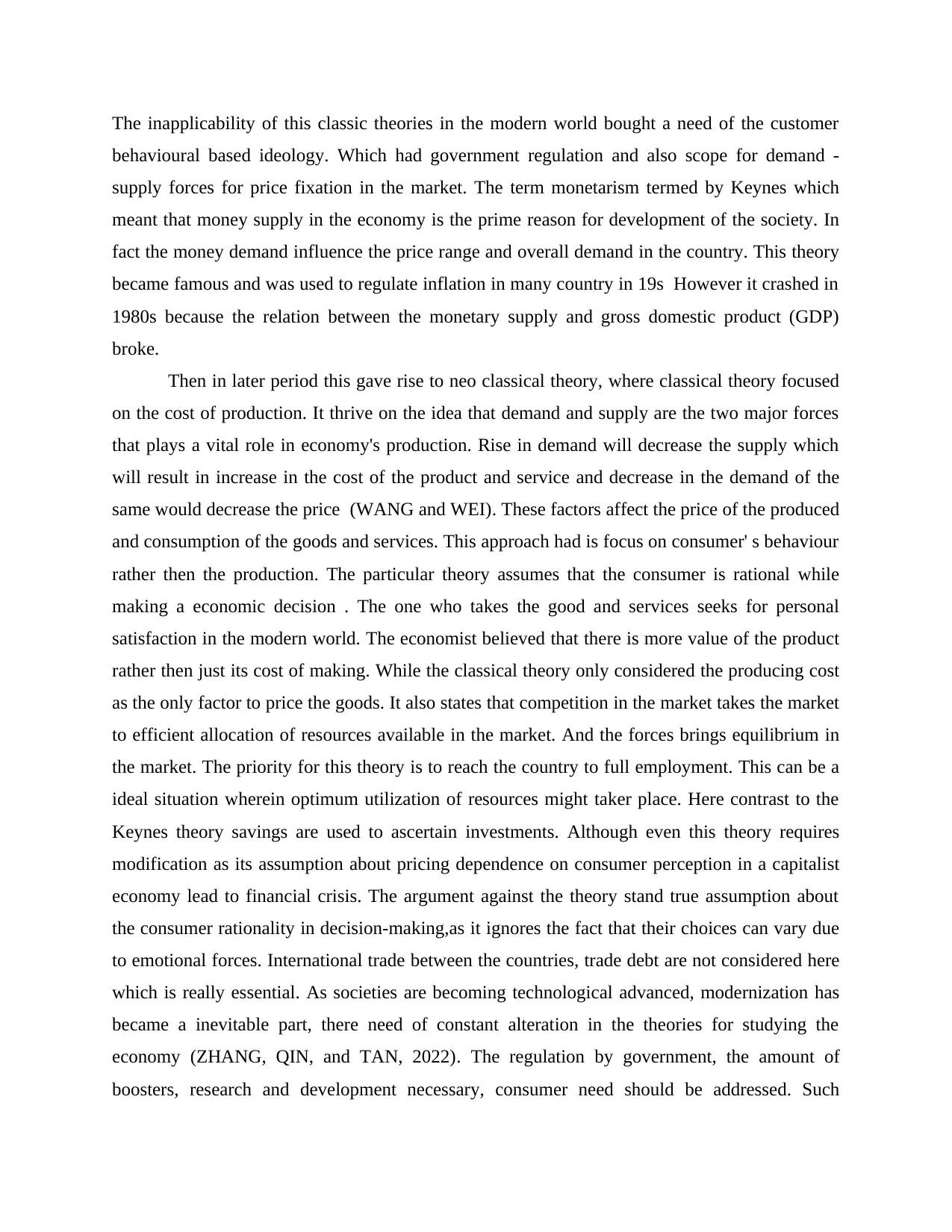
The inapplicability of this classic theories in the modern world bought a need of the customer
behavioural based ideology. Which had government regulation and also scope for demand -
supply forces for price fixation in the market. The term monetarism termed by Keynes which
meant that money supply in the economy is the prime reason for development of the society. In
fact the money demand influence the price range and overall demand in the country. This theory
became famous and was used to regulate inflation in many country in 19s However it crashed in
1980s because the relation between the monetary supply and gross domestic product (GDP)
broke.
Then in later period this gave rise to neo classical theory, where classical theory focused
on the cost of production. It thrive on the idea that demand and supply are the two major forces
that plays a vital role in economy's production. Rise in demand will decrease the supply which
will result in increase in the cost of the product and service and decrease in the demand of the
same would decrease the price (WANG and WEI). These factors affect the price of the produced
and consumption of the goods and services. This approach had is focus on consumer' s behaviour
rather then the production. The particular theory assumes that the consumer is rational while
making a economic decision . The one who takes the good and services seeks for personal
satisfaction in the modern world. The economist believed that there is more value of the product
rather then just its cost of making. While the classical theory only considered the producing cost
as the only factor to price the goods. It also states that competition in the market takes the market
to efficient allocation of resources available in the market. And the forces brings equilibrium in
the market. The priority for this theory is to reach the country to full employment. This can be a
ideal situation wherein optimum utilization of resources might taker place. Here contrast to the
Keynes theory savings are used to ascertain investments. Although even this theory requires
modification as its assumption about pricing dependence on consumer perception in a capitalist
economy lead to financial crisis. The argument against the theory stand true assumption about
the consumer rationality in decision-making,as it ignores the fact that their choices can vary due
to emotional forces. International trade between the countries, trade debt are not considered here
which is really essential. As societies are becoming technological advanced, modernization has
became a inevitable part, there need of constant alteration in the theories for studying the
economy (ZHANG, QIN, and TAN, 2022). The regulation by government, the amount of
boosters, research and development necessary, consumer need should be addressed. Such
behavioural based ideology. Which had government regulation and also scope for demand -
supply forces for price fixation in the market. The term monetarism termed by Keynes which
meant that money supply in the economy is the prime reason for development of the society. In
fact the money demand influence the price range and overall demand in the country. This theory
became famous and was used to regulate inflation in many country in 19s However it crashed in
1980s because the relation between the monetary supply and gross domestic product (GDP)
broke.
Then in later period this gave rise to neo classical theory, where classical theory focused
on the cost of production. It thrive on the idea that demand and supply are the two major forces
that plays a vital role in economy's production. Rise in demand will decrease the supply which
will result in increase in the cost of the product and service and decrease in the demand of the
same would decrease the price (WANG and WEI). These factors affect the price of the produced
and consumption of the goods and services. This approach had is focus on consumer' s behaviour
rather then the production. The particular theory assumes that the consumer is rational while
making a economic decision . The one who takes the good and services seeks for personal
satisfaction in the modern world. The economist believed that there is more value of the product
rather then just its cost of making. While the classical theory only considered the producing cost
as the only factor to price the goods. It also states that competition in the market takes the market
to efficient allocation of resources available in the market. And the forces brings equilibrium in
the market. The priority for this theory is to reach the country to full employment. This can be a
ideal situation wherein optimum utilization of resources might taker place. Here contrast to the
Keynes theory savings are used to ascertain investments. Although even this theory requires
modification as its assumption about pricing dependence on consumer perception in a capitalist
economy lead to financial crisis. The argument against the theory stand true assumption about
the consumer rationality in decision-making,as it ignores the fact that their choices can vary due
to emotional forces. International trade between the countries, trade debt are not considered here
which is really essential. As societies are becoming technological advanced, modernization has
became a inevitable part, there need of constant alteration in the theories for studying the
economy (ZHANG, QIN, and TAN, 2022). The regulation by government, the amount of
boosters, research and development necessary, consumer need should be addressed. Such
Paraphrase This Document
Need a fresh take? Get an instant paraphrase of this document with our AI Paraphraser
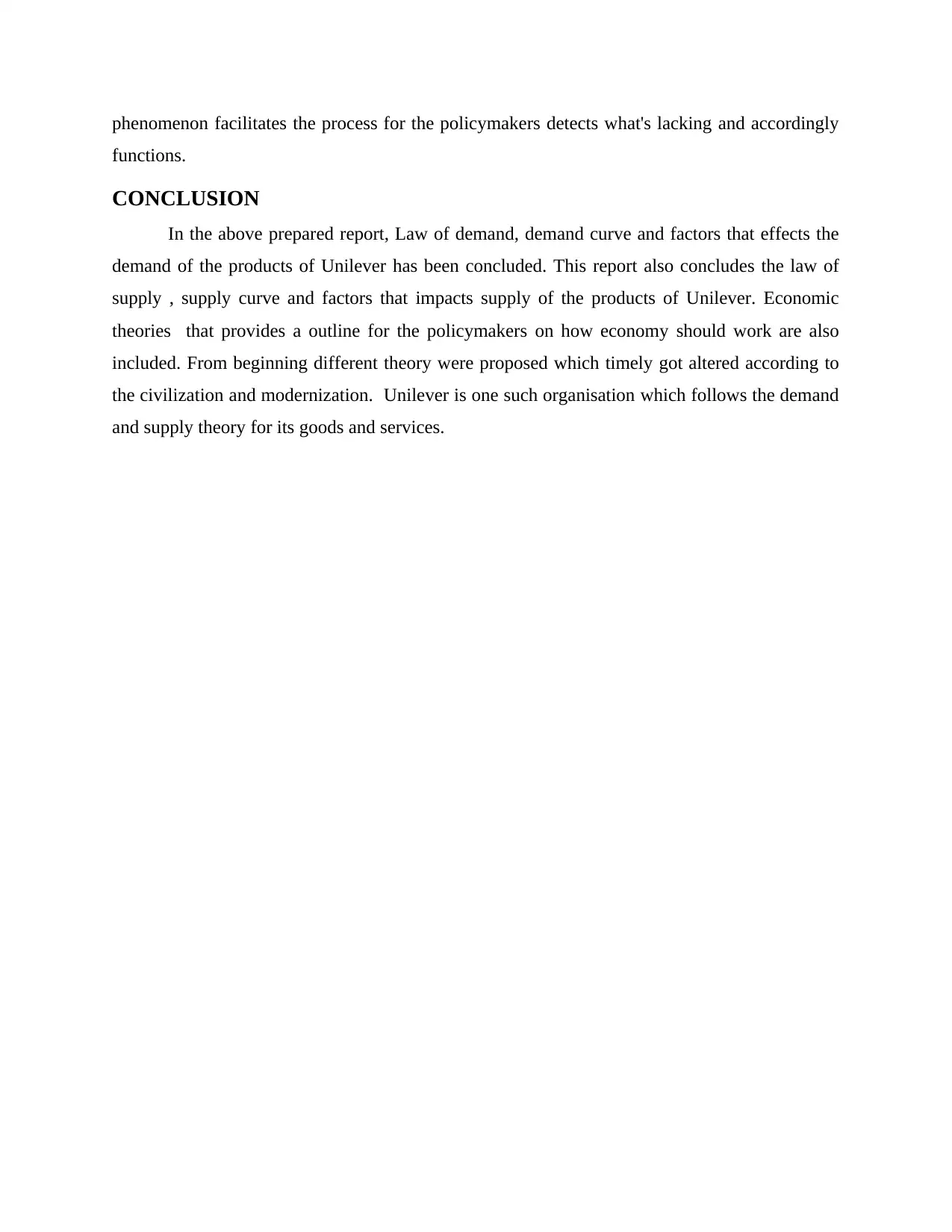
phenomenon facilitates the process for the policymakers detects what's lacking and accordingly
functions.
CONCLUSION
In the above prepared report, Law of demand, demand curve and factors that effects the
demand of the products of Unilever has been concluded. This report also concludes the law of
supply , supply curve and factors that impacts supply of the products of Unilever. Economic
theories that provides a outline for the policymakers on how economy should work are also
included. From beginning different theory were proposed which timely got altered according to
the civilization and modernization. Unilever is one such organisation which follows the demand
and supply theory for its goods and services.
functions.
CONCLUSION
In the above prepared report, Law of demand, demand curve and factors that effects the
demand of the products of Unilever has been concluded. This report also concludes the law of
supply , supply curve and factors that impacts supply of the products of Unilever. Economic
theories that provides a outline for the policymakers on how economy should work are also
included. From beginning different theory were proposed which timely got altered according to
the civilization and modernization. Unilever is one such organisation which follows the demand
and supply theory for its goods and services.
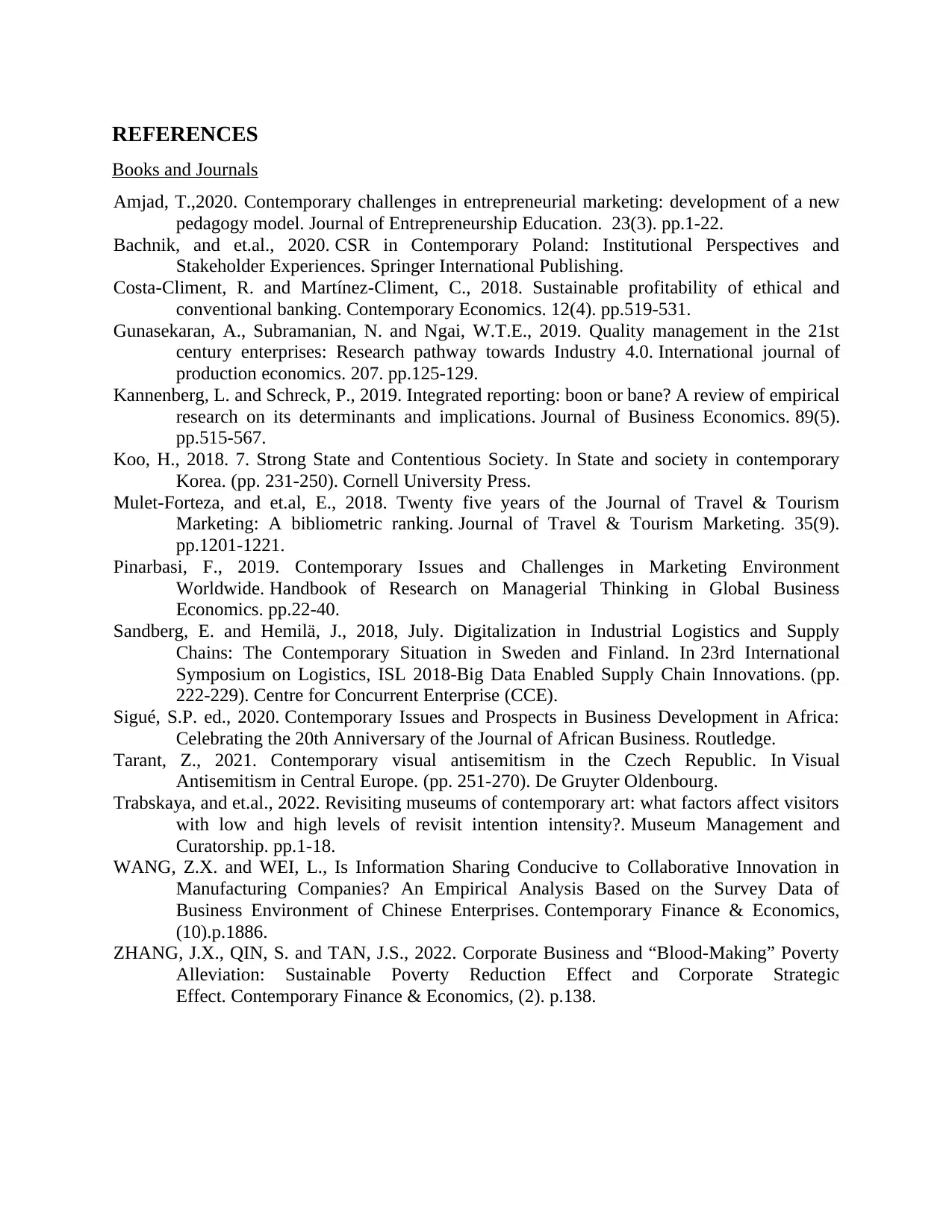
REFERENCES
Books and Journals
Amjad, T.,2020. Contemporary challenges in entrepreneurial marketing: development of a new
pedagogy model. Journal of Entrepreneurship Education. 23(3). pp.1-22.
Bachnik, and et.al., 2020. CSR in Contemporary Poland: Institutional Perspectives and
Stakeholder Experiences. Springer International Publishing.
Costa-Climent, R. and Martínez-Climent, C., 2018. Sustainable profitability of ethical and
conventional banking. Contemporary Economics. 12(4). pp.519-531.
Gunasekaran, A., Subramanian, N. and Ngai, W.T.E., 2019. Quality management in the 21st
century enterprises: Research pathway towards Industry 4.0. International journal of
production economics. 207. pp.125-129.
Kannenberg, L. and Schreck, P., 2019. Integrated reporting: boon or bane? A review of empirical
research on its determinants and implications. Journal of Business Economics. 89(5).
pp.515-567.
Koo, H., 2018. 7. Strong State and Contentious Society. In State and society in contemporary
Korea. (pp. 231-250). Cornell University Press.
Mulet-Forteza, and et.al, E., 2018. Twenty five years of the Journal of Travel & Tourism
Marketing: A bibliometric ranking. Journal of Travel & Tourism Marketing. 35(9).
pp.1201-1221.
Pinarbasi, F., 2019. Contemporary Issues and Challenges in Marketing Environment
Worldwide. Handbook of Research on Managerial Thinking in Global Business
Economics. pp.22-40.
Sandberg, E. and Hemilä, J., 2018, July. Digitalization in Industrial Logistics and Supply
Chains: The Contemporary Situation in Sweden and Finland. In 23rd International
Symposium on Logistics, ISL 2018-Big Data Enabled Supply Chain Innovations. (pp.
222-229). Centre for Concurrent Enterprise (CCE).
Sigué, S.P. ed., 2020. Contemporary Issues and Prospects in Business Development in Africa:
Celebrating the 20th Anniversary of the Journal of African Business. Routledge.
Tarant, Z., 2021. Contemporary visual antisemitism in the Czech Republic. In Visual
Antisemitism in Central Europe. (pp. 251-270). De Gruyter Oldenbourg.
Trabskaya, and et.al., 2022. Revisiting museums of contemporary art: what factors affect visitors
with low and high levels of revisit intention intensity?. Museum Management and
Curatorship. pp.1-18.
WANG, Z.X. and WEI, L., Is Information Sharing Conducive to Collaborative Innovation in
Manufacturing Companies? An Empirical Analysis Based on the Survey Data of
Business Environment of Chinese Enterprises. Contemporary Finance & Economics,
(10).p.1886.
ZHANG, J.X., QIN, S. and TAN, J.S., 2022. Corporate Business and “Blood-Making” Poverty
Alleviation: Sustainable Poverty Reduction Effect and Corporate Strategic
Effect. Contemporary Finance & Economics, (2). p.138.
Books and Journals
Amjad, T.,2020. Contemporary challenges in entrepreneurial marketing: development of a new
pedagogy model. Journal of Entrepreneurship Education. 23(3). pp.1-22.
Bachnik, and et.al., 2020. CSR in Contemporary Poland: Institutional Perspectives and
Stakeholder Experiences. Springer International Publishing.
Costa-Climent, R. and Martínez-Climent, C., 2018. Sustainable profitability of ethical and
conventional banking. Contemporary Economics. 12(4). pp.519-531.
Gunasekaran, A., Subramanian, N. and Ngai, W.T.E., 2019. Quality management in the 21st
century enterprises: Research pathway towards Industry 4.0. International journal of
production economics. 207. pp.125-129.
Kannenberg, L. and Schreck, P., 2019. Integrated reporting: boon or bane? A review of empirical
research on its determinants and implications. Journal of Business Economics. 89(5).
pp.515-567.
Koo, H., 2018. 7. Strong State and Contentious Society. In State and society in contemporary
Korea. (pp. 231-250). Cornell University Press.
Mulet-Forteza, and et.al, E., 2018. Twenty five years of the Journal of Travel & Tourism
Marketing: A bibliometric ranking. Journal of Travel & Tourism Marketing. 35(9).
pp.1201-1221.
Pinarbasi, F., 2019. Contemporary Issues and Challenges in Marketing Environment
Worldwide. Handbook of Research on Managerial Thinking in Global Business
Economics. pp.22-40.
Sandberg, E. and Hemilä, J., 2018, July. Digitalization in Industrial Logistics and Supply
Chains: The Contemporary Situation in Sweden and Finland. In 23rd International
Symposium on Logistics, ISL 2018-Big Data Enabled Supply Chain Innovations. (pp.
222-229). Centre for Concurrent Enterprise (CCE).
Sigué, S.P. ed., 2020. Contemporary Issues and Prospects in Business Development in Africa:
Celebrating the 20th Anniversary of the Journal of African Business. Routledge.
Tarant, Z., 2021. Contemporary visual antisemitism in the Czech Republic. In Visual
Antisemitism in Central Europe. (pp. 251-270). De Gruyter Oldenbourg.
Trabskaya, and et.al., 2022. Revisiting museums of contemporary art: what factors affect visitors
with low and high levels of revisit intention intensity?. Museum Management and
Curatorship. pp.1-18.
WANG, Z.X. and WEI, L., Is Information Sharing Conducive to Collaborative Innovation in
Manufacturing Companies? An Empirical Analysis Based on the Survey Data of
Business Environment of Chinese Enterprises. Contemporary Finance & Economics,
(10).p.1886.
ZHANG, J.X., QIN, S. and TAN, J.S., 2022. Corporate Business and “Blood-Making” Poverty
Alleviation: Sustainable Poverty Reduction Effect and Corporate Strategic
Effect. Contemporary Finance & Economics, (2). p.138.
⊘ This is a preview!⊘
Do you want full access?
Subscribe today to unlock all pages.

Trusted by 1+ million students worldwide
1 out of 12
Related Documents
Your All-in-One AI-Powered Toolkit for Academic Success.
+13062052269
info@desklib.com
Available 24*7 on WhatsApp / Email
![[object Object]](/_next/static/media/star-bottom.7253800d.svg)
Unlock your academic potential
Copyright © 2020–2025 A2Z Services. All Rights Reserved. Developed and managed by ZUCOL.


